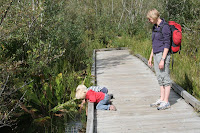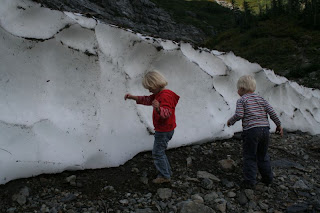 In the moment we try to prepare the garden for winter time. We got told from neighbors that it is possible to grow some vegetables in winter time and thus we try. Katrin and the kids planted broccoli and salad seeds. The broccoli sprouted already, but will it really grow during fall and winter? I am still skeptical, but looking forward to home grown harvests. I will try to get some railroad ties as soon as possible, so they can finish the raised bed for the veggies. Do we need to cover it? - When we moved in a lot of plants suffered from the draught and some roots Hanna did find and moved to new places did not look too good in my eyes - anyway they seem to do pretty well, despite it is already mid-September they grow at a significant rate. Maybe, with the certain care even vegetables will flourish over fall and winter. I will check if I find some good online resources for this climate zone about that topic. Mild and wet winters seem not to be a major threat for most plants.
In the moment we try to prepare the garden for winter time. We got told from neighbors that it is possible to grow some vegetables in winter time and thus we try. Katrin and the kids planted broccoli and salad seeds. The broccoli sprouted already, but will it really grow during fall and winter? I am still skeptical, but looking forward to home grown harvests. I will try to get some railroad ties as soon as possible, so they can finish the raised bed for the veggies. Do we need to cover it? - When we moved in a lot of plants suffered from the draught and some roots Hanna did find and moved to new places did not look too good in my eyes - anyway they seem to do pretty well, despite it is already mid-September they grow at a significant rate. Maybe, with the certain care even vegetables will flourish over fall and winter. I will check if I find some good online resources for this climate zone about that topic. Mild and wet winters seem not to be a major threat for most plants.Last weekend was packed with nice activities again. Saturday was a rainy day, nearly ideal for our first orienteering meet here in Seattle. They held a newcomer event in the Woodland Park right next to the zoo. We met many nice people and joined the Cascade Orienteering Club (COC). Katrin did a stroller friendly 1.5km beginners course with the kids and I went onto a 3.5km course. Knowing orienteering maps I was quite surprised at the start line picking up the map for course 3. It had the outer limits of the park marked, out of bound areas marked, a few stones and height contours - nothing else. Well, in a park like this any more information probably would not justify to call it orienteering otherwise. Anyway I thought it is a great idea for training, since I normally don't really pay enough attention to height contours and go more for special objects. This way I had to concentrate on them and found it to be a great experience - I think I need more training orienteering maps with purely height contours (not even vegetation). Orienteering season is just starting over here, since ground vegetation is to thick in summer they mainly meet in fall, winter and early spring.
After orienteering we headed straight to the US Health Works to get a tuberculosis test. We do need this for our voluntary work at pre-school once a week with the twins. They injected something just under the skin on the arm and rechecked the arms today for a anti-body reaction on that spot. Both our tests were negative; thus not stopping us from taking turns working with the kids now. On our way home we stopped at a hardware store, getting a second set of keys for our car and buying spate and fork for gardening. The rest of the day we used just for relaxing and hanging around the house. At night looking at the National Forest Services web page we decided to go hiking again on Sunday.
 After baking fresh raisin buns and having a reasonable quick breakfast we were on the road by ten. We drove straight to the Verlot ranger station and visitor information and bought an annual pass for the North West National forests (since we definitely will be in all the national forests around Seattle more than five times a year). We had a rough idea where to go but asked the ranger for further suggestions in that area of what to do with kids. She suggested the "Big Four Ice Cave Trail". It was another 14 miles up into the mountains.
After baking fresh raisin buns and having a reasonable quick breakfast we were on the road by ten. We drove straight to the Verlot ranger station and visitor information and bought an annual pass for the North West National forests (since we definitely will be in all the national forests around Seattle more than five times a year). We had a rough idea where to go but asked the ranger for further suggestions in that area of what to do with kids. She suggested the "Big Four Ice Cave Trail". It was another 14 miles up into the mountains.Arriving at the parking lot I knew why they call it the Big Four: a steep mountain with nearly identical peaks.
It was a 1.1 mile hike to the base of the nearly vertical wall of that mountain and the ice field.
Due to wind circulation underneath the ice shield the massive caves form in late summer. It can be lethal to enter them, since constant melting makes them pretty unstable. Standing in front of them was amazing enough. It is hard to guess how high the cave was, but certainly 8 to 10m - just have a look at the pictures we took.
If I understood it right, even several ice caves can form in some years. Despite quite a warm day, the air blowing out of these caves was freezing cold. They form since huge amounts of snow slide down the steep face of the mountain in numerous avalanches during winter time. There is more than enough proof of these destructive avalanches in the forest several hundred meters away. In the closer vicinity of the ice shield only shrugs are growing.
 Due to the cold air fan we did not stay very long at the cave to the disappointment of the kids, but it was just too cold. Maybe we should have checked the other ice shields, but we headed back from that north facing shading spreading wall into the sun. We did some huckleberry picking on the way back to the river bed, we crossed on our way up. Amazing that there are still man-high bushes full of huckleberries around this time of the year. (Huckleberries are a type of blueberry, also called 'American Blueberries')
Due to the cold air fan we did not stay very long at the cave to the disappointment of the kids, but it was just too cold. Maybe we should have checked the other ice shields, but we headed back from that north facing shading spreading wall into the sun. We did some huckleberry picking on the way back to the river bed, we crossed on our way up. Amazing that there are still man-high bushes full of huckleberries around this time of the year. (Huckleberries are a type of blueberry, also called 'American Blueberries')Finally arriving in the warm sun of the river bed we had an extended late picnic lunch. Chocolate, fruits, veggies and many raisin buns! At different times of the year the position we sat is most likely covered under water just above freezing point. Luckily we had a dry warm late summer ;-).
Narne enjoys all the hikes in is backpack seat on my back, but we try to take him out of there as soon as we stop, though he never complained about being up there at all yet. He really seems to like that position up there overlooking everything.
 The hike was only 1.1 mile per direction, but we did not want to do anything more challenging for the kids. Enough to experience, do and explore is on the shortest trail. Again we faced a little furry fellow we were not able to identify. We realized that we are in urgent need of a small light, but still comprehensive field guide of birds, plants and mammals (deliberately left out insects and reptiles in this list). Maybe depending on the area of the hike, one for the shore line, one for in land lakes and one for the mountains is needed. The ranger station had a variety of them, but we did not decide yet which one - but we did buy a book: Hiking in the North West with children. It is a description of 184 hikes in Washington state that are suited for kids. We will see if we only stick to them or find even more nice ones. Looking in the internet I realized already that trying to hike every single trail in Washington would take a live time, thus we better stick only to the most recommended ones and a few lucky choices, for the time we have here.
The hike was only 1.1 mile per direction, but we did not want to do anything more challenging for the kids. Enough to experience, do and explore is on the shortest trail. Again we faced a little furry fellow we were not able to identify. We realized that we are in urgent need of a small light, but still comprehensive field guide of birds, plants and mammals (deliberately left out insects and reptiles in this list). Maybe depending on the area of the hike, one for the shore line, one for in land lakes and one for the mountains is needed. The ranger station had a variety of them, but we did not decide yet which one - but we did buy a book: Hiking in the North West with children. It is a description of 184 hikes in Washington state that are suited for kids. We will see if we only stick to them or find even more nice ones. Looking in the internet I realized already that trying to hike every single trail in Washington would take a live time, thus we better stick only to the most recommended ones and a few lucky choices, for the time we have here. 







No comments:
Post a Comment